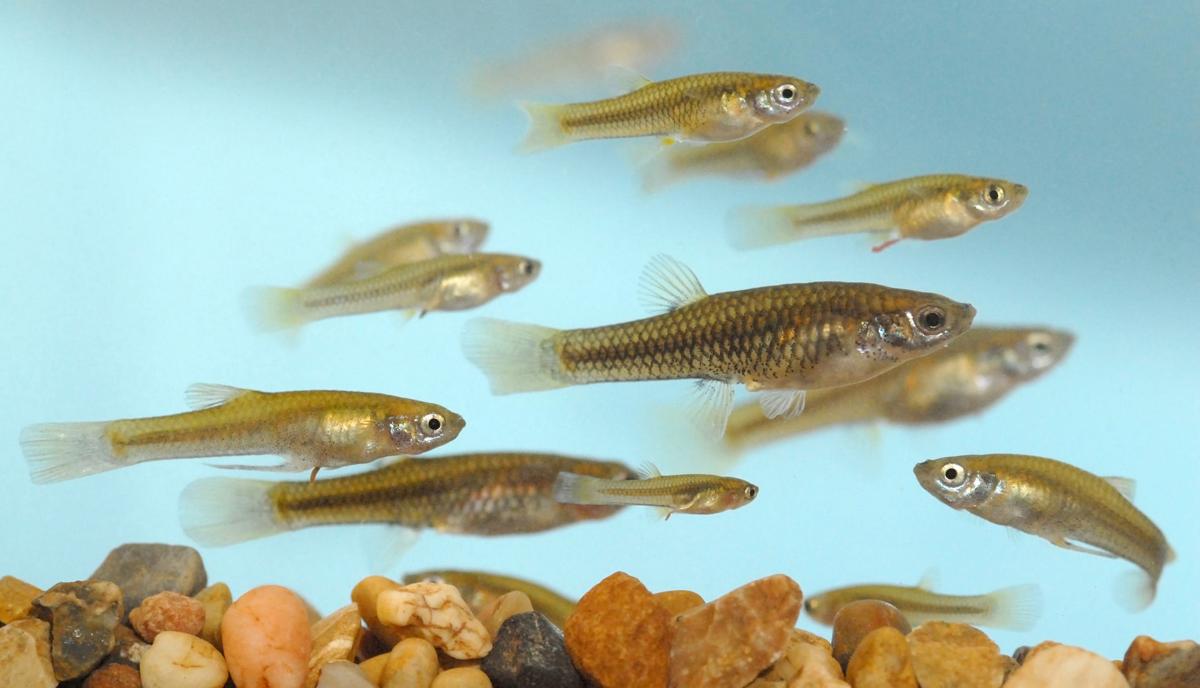The Gila topminnow was first captured and named on the Santa Cruz River more than 150 years ago. Seventy-five years ago, it was one of the most-common native fish in the Lower Gila River Basin across Southern and Central Arizona.
The tiny fish, 1- to 2-inches long, has struggled since then. It landed on the endangered-species list nearly 50 years ago due partly to competition from non-natives like the ubiquitous mosquitofish. But now, it appears to be doing well in the Upper Santa Cruz near Tubac, about 40 miles south of Tucson.
Counts of the endangered Gila topminnow jumped there this year — a sign to biologists that pollution cleanups work. The spike shows how the fragile river — which carries mostly sewage effluent — is recovering due to the upgrade of a Nogales sewage treatment plant seven years ago.
Someday, these topminnows or their descendants could find their way to the next wet stretch of Santa Cruz, just below two Tucson-area sewage plants. Surveys as recent as this fall have found only non-native fish there.
Biologists sampling the river in November captured 135 Gila topminnow. They were found at the Tubac Bridge and the Santa Gertrudis Lane crossing, both in Santa Cruz County, said Peter Reinthal, an adjunct professor at the University of Arizona’s Department of Ecology and Evolutionary Biology.
That compared to eight captured a year earlier along the river.
On the same day the latest samples were taken, federal fish biologist Doug Duncan saw more than 200 topminnow in a small pool near Santa Gertrudis, in an anecdotal observation that didn’t involve sampling.
“We are thrilled to be finding them this numerous since this is a good indicator that their return last year was not a brief blip on the radar,” said Duncan, of the U.S. Fish and Wildlife Service.
The topminnow, a thin fish with tan- to olive-colored bodies, was first collected in the Santa Cruz near Tucson in 1851. Its numbers dropped dramatically after World War II due to non-native competition, groundwater pumping and other forces that have damaged many of Arizona’s native fish populations. Until last year, it hadn’t been seen in the Upper Santa Cruz since 2005.
The main credit for the topminnow’s improved presence here goes to the federal government’s $59 million project to improve the Nogales International Wastewater Treatment Plant, said Reinthal and Claire Zugmeyer, an ecologist for the Sonoran Institute, which is involved in the Santa Cruz fish monitoring.
Before the upgrade was finished in 2009, the plant was polluting the Upper Santa Cruz with discharges high in ammonia and phosphorus.
The Upper Santa Cruz wouldn’t have much water except during floods without the treated sewage effluent that flows from the wastewater plant to as far north as Chavez Siding Road north of Tubac.
Flooding also could have made a difference, Reinthal said.
“There are topminnow in Upper Sonoita Creek and they could have colonized (the Santa Cruz) during flooding events. There were also good summer rains and the populations could be increasing due to good conditions,” he said. “Topminnow populations can respond to environmental fluctuations very quickly.”
Many of these topminnows had the same genetic signatures as those living in Sonoita Creek, Duncan said. But some had a different genetic signature that has been found in topminnows along the Santa Cruz in Mexico as recently as this year, he said.
Scientists said this topminnow increase is significant because:
- While the topminnow is more prevalent in the Southwest than in the 1980s and 1990s due to recovery efforts, the Santa Cruz has the only population in a major river or other waterway, Reinthal said.
- The importance of the topminnow’s improvement on the Santa Cruz extends beyond Arizona. Many Southwestern rivers and streams depend on effluent to flow continuously, and as fresh water grows more scarce, effluent’s value will increase, Zugmeyer said. “Often communities discharge effluent into rivers out of convenience and not with intent to benefit the environment,” she said. “We are now seeing that highly treated wastewater is a vital component to maintaining this region’s living river.” Using effluent, “We can create rich oases for both people and wildlife while simultaneously benefiting from ... flood control, recharge, and cooling riparian vegetation.”
- The Santa Cruz’s topminnow are surviving despite the presence of large numbers of non-native mosquitofish. They eat topminnow and are considered a major cause of their past decline, Reinthal said. But the regular flooding in the river allows the two species to coexist because the floods flush the even tinier mosquitofish downstream where many are killed, Duncan said.
As for the topminnow’s long-term outlook on the Santa Cruz, Duncan said, “As long as they keep water in it, it will be good.”





